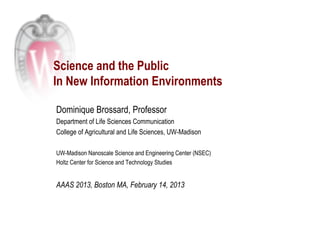Brossard aaas 13 0214
- 1. Science and the Public In New Information Environments Dominique Brossard, Professor Department of Life Sciences Communication College of Agricultural and Life Sciences, UW-Madison UW-Madison Nanoscale Science and Engineering Center (NSEC) Holtz Center for Science and Technology Studies AAAS 2013, Boston MA, February 14, 2013
- 2. This Talk: An Overview ?? The online environment for science news ?? The science information consumer ?? Online content and science ?? To comment or not to comment?
- 3. Science Communication is Redefined Ī░itĪ»s not possible to talk about science blogging without talking about scientists blogging, or more broadly about scientists writing.Ī▒ Franci, M. (2011). Nature Chemistry 3, 183-184
- 4. ĪŁDirect Communication Endorsed Particularly By Younger Scientists ?? cohort shifts with more junior scientists thinking that Ī░[n]ew findings of public interest should be communicated to the public immediatelyĪ▒ (Data based on: Corley et al. 2011) 4
- 5. ĪŁ And (Science) Information Can Go Viral ?? Political news through indirect channnels ?? Penn Virality study Berger & Milkman 2010 5
- 6. THE PROMISE OF THE New Communication Environments ĪŁ NEW INATION COMEALTH ?? provide essentially unlimited information ?? on a large number of issues, ?? which can be obtained anywhere and ?? with relatively limited effort ?? and opportunities for citizens to connect with others through social media and other 2.0-type tools to make sense of this information 10
- 7. This Talk: An Overview ?? The online environment for science news ?? The science information consumer ?? Online conversations about science ?? To comment or not to comment?
- 8. A New Active Online Science Audience Online National Science Board 2012 15
- 9. Aggregate Cohort Shifts Among Audiences For Science Information Su et al.. 2012 12
- 10. But For Now, These Shifts Are Not Across The Board BUT FOR NOW, THESE SHIFTS ARE 60 NOT ACROSS THE BOARD (scale range partially displayed) male 55 female Percentage 50 45 40 Traditional media Television Newspaper Online / Online-Only mixed (20% of pop.) (16% of pop.) Traditional media (7% of pop.) (23% of pop.) mixed (34% of pop.) Su et al. 2012 13
- 11. BUT FOR NOW, THESE SHIFTS ARE But For Now, These Shifts Are Not Across The Board NOT ACROSS THE BOARD 65 Education low (scale range partially displayed) 60 Education high 55 Percentage 50 45 40 35 Traditional media Television Newspaper Online / Online-Only mixed (20% of pop.) (16% of pop.) Traditional media (7% of pop.) (23% of pop.) mixed (34% of pop.) Su et al. 2012 14
- 12. This Talk: An Overview ?? The online environment for science news ?? The science information consumer ?? Online content and science ?? To comment or not to comment?
- 13. What Do These New Information Environments Look Like for the Science Information Consumer? ?? For nanotechnology, discrepancy between ?? Searches: ?? what people look for (tracked by Nielsen online) ?? Results: ?? what search terms are suggested to them (Google suggest data) ?? what they find (content analysis of top ranked search results in Google) Ladwig et al. 2010 17
- 14. What This Means for Science-Informed Audiences ?? Potential of Ī░self-reinforcing informational spiralsĪ▒ Page Google ranks Suggestions Traffic Searches ?? Are opinions formed based on how Google presents results rather than on what individuals are searching? Li et al. 2011; Brossard & Scheufele 2013 18
- 15. Information is Contextualized ?? Online newspaper articles or TV shows not consumed in isolated fashion, but contextualized ?? reader comments and feedback ?? Facebook posts/links with Ī░LikeĪ▒ buttons and comments from other users ?? Tweets - RT ?? ĪŁ ?? ĪŁ how are these formats impacting consumers views? 19
- 16. Online Conversations Are Not Neutral Emotions Uncertainty Disagreement Name calling
- 17. Tone of Comments In Blogs Change Our Judgments About Online Science Stories ?? Experiment involving a representative sample of the American population (N=1,183) ?? Subjects randomly assigned to 2 types of comments following a balanced news story about nanosilver: ?? Rude blog comments ?? Civil blog comments Anderson et al. (in press) 20
- 18. Predicting Nanotechnology Risk Perception (benefits < risk)
- 19. In a nutshell ĪŁ People who read the uncivil comments (which use the same screen names and content and just differ on the tone) end up walking away from the story with a much more polarized understanding of the actual risks connected with nano
- 22. In Sum ĪŁ ?? An evolving science communication environment, in which the science information consumer constantly encounters contextualized information in an online world ?? How do we deal with comments? ?? Research in science communication needs to inform online science communication practice 21
- 23. Thank you <dbrossard@wisc.edu> Twitter: @brossardd lsc.wisc.edu scimep.wisc.edu




![ĪŁDirect Communication Endorsed
Particularly By Younger Scientists
?? cohort shifts with more junior
scientists thinking that Ī░[n]ew
findings of public interest should be
communicated to the public
immediatelyĪ▒
(Data based on: Corley et al. 2011)
4](https://image.slidesharecdn.com/brossardaaas13-0214-130327104324-phpapp02/85/Brossard-aaas-13-0214-4-320.jpg)


















